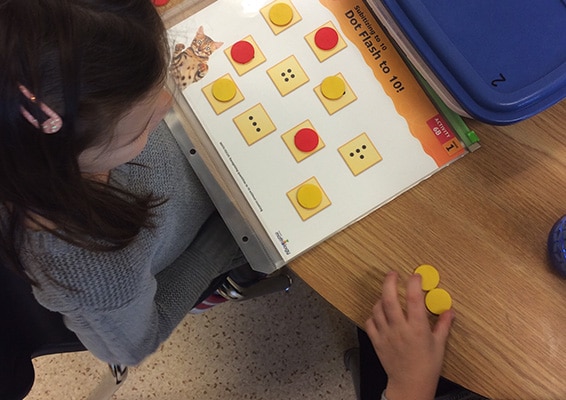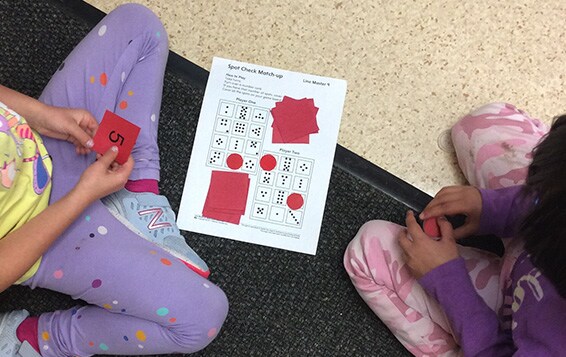Tackling the Challenges of Teaching Math
Using Mathology to differentiate and connect math to real life
Shammy Gill’s grade one classroom challenges are similar to those of many Canadian teachers. Her school—Martha Jane Norris Elementary School in Surrey, BC—has a high population of English Language Learners (ELL) and, in her classroom, students’ ability levels vary widely.
In her 15 years of teaching kindergarten to grade two students, Gill constantly searched for better ways to engage students in math and help them excel.
But finding effective ways to differentiate and connect math to real life wasn’t easy. Searching for quality books, games, and activities to support her efforts was time consuming. And while she made great strides, she often felt her students needed more.
Then Gill discovered Pearson’s Mathology resources.
She found support in Mathology’s versatile resources including Little Books, activities, and assessment. Now, Gill says assessment and differentiation are easier, students are more confident and engaged, and students are learning to see math in everyday life.
Here are a few of the ways Gill says Mathology has helped her and her grade one students.
“Overall, I love that the Mathology program is hands-on and games-oriented. The kids really enjoyed that aspect of it. Everything’s in there, there’s whole-group lessons, small-group lessons, and independent activities. The whole program is just so fantastic!”
Shammy Gill

Quality differentiation resources at her fingertips
Gill says Mathology gives her easy access to lessons, activities, and books that are just right for students at every level of math learning in her class—whether they’re just learning to count or can do early grade three math.
“I used to have to search and pull activities from different programs,” she explains. “But with Mathology, differentiation was so much easier because everything was in one central place.”
“There are so many lessons, I can pick and choose what I want to do with the whole group or with a small group. And with the Little Books, as we progress during the year, kids can move on with different books, while groups that struggle use books we used previously.”
“I used to have to search and pull activities from different programs,” she explains. “But with Mathology, differentiation was so much easier because everything was in one central place.”
Shammy Gill
Just-in-time suggestions for struggling students
Gill says she’s also discovered new ways to reach struggling students, thanks to the suggestions for next steps included in Mathology’s activity cards. In previous years, Gill recalls feeling stuck and not knowing what to do next when, despite teaching a concept several ways, a struggling student still didn’t grasp the idea.
“But with Mathology, the activity cards have suggestions for next steps to try if a student is struggling. And those next steps are so beneficial, especially when I work with struggling students.”
“Compared to other grade-one level groups I’ve taught, I noticed my students were more confident, especially in breaking numbers apart to ten. And that’s because we did so much practice. But while the activities repeated concepts, they did it in different ways and different formats that I probably wouldn’t have come up with on my own.”
Shammy Gill

Clear connections between math and everyday life
While connecting math to real life is important in any classroom, Gill says that’s especially true in a school with a high ELL population. And each of Mathology’s Little Books tie into real-life concepts, like going shopping, spending time at the park with a grandparent, and just noticing math in the real world.
“Being able to tie in that oral language connection is just fantastic! And the Little Books help students make those connections about why math is important and see how math is everywhere and you use it when you’re not even really thinking about it.”
Results
Along with supporting Gill’s teaching efforts, she’s also noticed an increase in students’ math confidence since they started using Mathology resources.
“Compared to other grade-one level groups I’ve taught, I noticed my students were more confident, especially in breaking numbers apart to ten. And that’s because we did so much practice. But while the activities repeated concepts, they did it in different ways and different formats that I probably wouldn’t have come up with on my own.”
“Being able to tie in that oral language connection is just fantastic! And the Little Books help students make those connections about why math is important and see how math is everywhere and you use it when you’re not even really thinking about it.”
Shammy Gill
Gills says Mathology helped her with student assessment as well. “I was assessing a lot more because of the assessment prompts on the activity cards. And I had a central location to keep my notes, which was helpful because before I would just keep notes on Post-Its and things like that. And the checklist was helpful for making sure I had assessed the child for each skill.”
“Overall, I love that Mathology is hands-on and games-oriented. The kids really enjoyed that aspect of it. Everything’s in there, there’s whole-group lessons, small-group lessons, and independent activities. The whole program is just so fantastic!”


